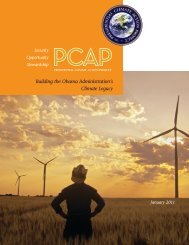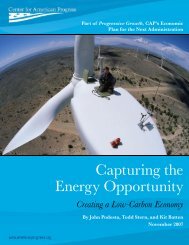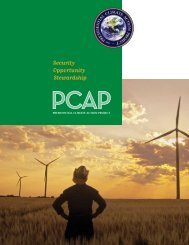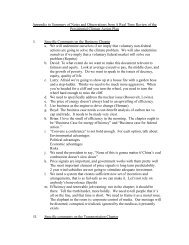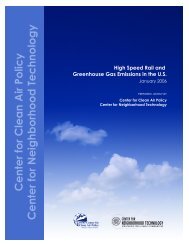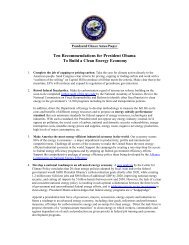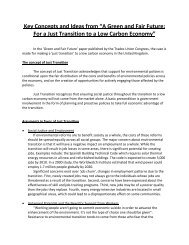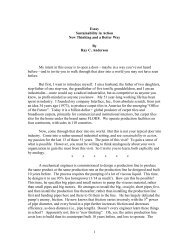PCAP - Presidential Climate Action Project
PCAP - Presidential Climate Action Project
PCAP - Presidential Climate Action Project
- No tags were found...
You also want an ePaper? Increase the reach of your titles
YUMPU automatically turns print PDFs into web optimized ePapers that Google loves.
The President should establish the following goals, milestones andperformance indicators for national energy policy: …By 2020: About 20%-30% of the nation’s electricity will be generatedfrom renewable resources; . . . <strong>PCAP</strong> Report 3:5.This target is framed in terms of recalibrating the energy plan. The President has a key role inplanning national energy policy. One of the targets in the LCES is a specific goal to increase thepercentage of energy derived from renewable resources (although the target expired in 2005),and one of the LCES priorities is to “promote the use of renewable energy resources, includingsolar, geothermal, sustainable biomass, hydropower, and wind power.” 100 Further, it seemsunavoidable that CO 2 as well as other GHGs will be regulated as pollutants under the CAA. SeeProposal B-7. The purpose of the regulation is to reduce emissions of air pollutants fromcategories of sources. Stationary sources, such as power generating facilities are regulated underSection 111. 101 In addition, the DOE, acting pursuant to the Renewable Energy and EnergyEfficiency Technology Competitiveness Act, is pursuing “an aggressive national program ofresearch, development, demonstration, and commercial application of renewable energy andenergy efficiency technologies. . . .” The Act is based on the congressional finding that, “it is inthe national security and economic interest of the United States to foster greater efficiency in theuse of available energy supplies and greater use of renewable energy technologies.” 1026) Reduce economy-wide energy demand at least 2.5% annually, leading to a reduction of25% by 2020 and 50% by 2030.The President should establish the following goals, milestones andperformance indicators for national energy policy:From 2010 to 2050: Economywide energy demand will be reduced at least2.5% annually, leading to reductions of at least 25% by 2020 and 50% by2030. The savings will involve all sectors – buildings, industry,transportation and energy supply. <strong>PCAP</strong> Report 3:4.The President should champion congressional approval of a nationalportfolio standard that codifies the energy efficiency and renewableenergy goals listed above, requiring electric power providers to obtain atleast 20% of their electricity from renewable resources by 2020. Startingin 2010, electric utilities would be required to reduce their baselineelectric sales by 0.6% annually through efficiency. Natural gas utilitieswould be required to reduce baseline gas sales annually by 0.3%. <strong>PCAP</strong>Report 3:6.100 42 U.S.C. § 13382(a)(4), (d)(4).101 Id. at § 7411; Boundaries Report, Chapter VIII(1). See also, Boundaries Report, Chapter IV(C)(2) (review oflegislation passed in the 1970s to promote the use of alternative fuels by powerplants).102 42 U.S.C. § 12002(a),(b).CEES 23 | P age



